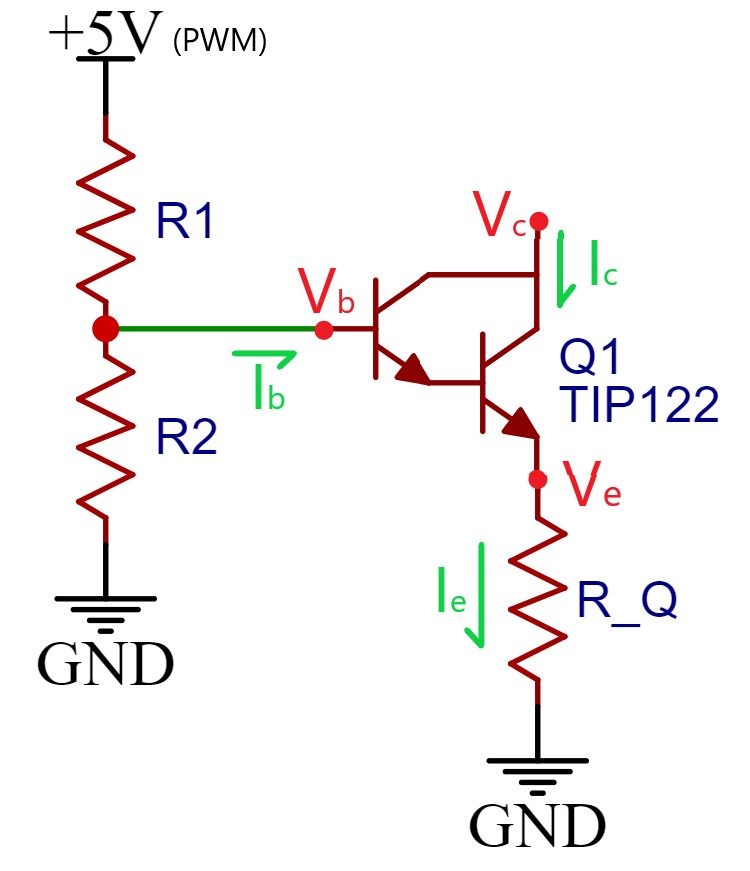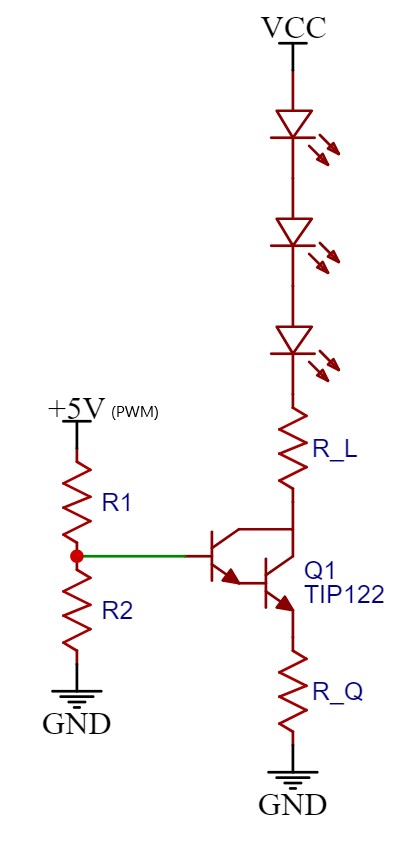I'm trying to design a dimmable LED circuit board. It's controlled by an Arduino with its PWM signals. I'm new to electronics so I have some question regarding my design and knowledge on it. I've attached two diagrams I've made to help with the visualization. Vcc is 24 VDC and the 5 V is the PWM pin from the Arduino.
The idea is to control the RGB LEDs (1 W per channel) using a TIP122 Darlington transistor. From what I know, there is about a 1.4 V drop from the base to the emitter in the TIP122 (Vb-Ve = 1.4 V). The voltage at the collector and base should be the same (Vc = Vb). The base voltage is the voltage out of the voltage divider (R1 and R2). If R1 is equal to R2 (R1 = R2), then Vb should be half of 5 V or 2.5 V (Vb = 2.5 V). From that, the emitter voltage is 1.1 V (Ve = Vb - 1.4 V = 1.1 V).
The emitter current is the summation of the base current and collector current. However, the base current is super small compared to the collector's current so we can assume the emitter current is the same as the collector current (Ie = Ic). By changing the value of resistor (R_Q) after the TIP122, we can control the current flowing through the circuit (Ie = Ve/R_Q = 1.1 V/R_Q). This is assuming that the current gain is not larger than 1000.
From beginner LED circuits, I’m supposed to put a resistor (R_L) in series with the LED(s) to limit the current flowing through the LED and prevent the LED from being destroyed. But if the resistor after the TIP122 will limit the current, do I still need the R_L resistor?
As an example, let’s use the circuit in the second diagram. The usable voltage that can power the LED would be the difference between the supply voltage and the voltage at the TIP122 collector (Vcc-Vc = 24V-2.5V = 21.5V). Let’s assume the 3 LEDs in series each have a forward voltage of 6 V (Vf = 6 V) and a forward current of 750 mA (If = 750 mA), so there is 18 V of total forward voltage and 3.5 V left over (21.5 V – 3*6 V = 3.5 V). Now normally, we’d put a 4.67 Ω resistor (R_L = 3.5 V/750 mA = 4.67 Ω) to keep the current flowing through the LEDs at 750 mA. But with the TIP122 and R_Q, is the R_L still necessary? If R_L is not needed, would that still be true even when the leftover voltage is a lot larger? So say two LEDs in series instead of three giving a leftover 9.5 V instead.
If anything I said is false, please let me know. I’m just explaining my thought process in my design and would appreciate any feedback on it.


